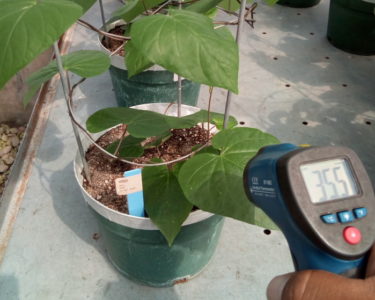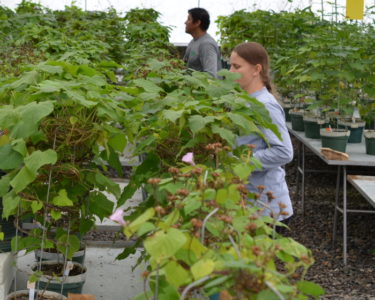
Drought has always posed a threat to agriculture, and over the past 50 years, many regions have experienced longer and harsher droughts. This is especially a problem in sub-Saharan Africa, where 96% of farmers rely on rainfall to grow their crops, and models predict that the frequency and intensity of droughts will increase as climate change advances.
Scientists across the globe are trying to breed climate-resilient crop varieties and develop tools that can help farmers produce enough food in future climates. Sweetpotato has the potential to play an important role in this quest, given its high levels of resilience, productivity and nutritional content.
A study of drought tolerance in sweetpotato’s wild relatives recently published in Frontiers in Plant Science could contribute to efforts to improve sweetpotato’s climate resilience. The results provide insight into those species’ potential for use in breeding climate-smart sweetpotatoes and a technique that could enhance the crop’s response to water stress after planting.
Scientists at the International Potato Center (CIP) and Universidad Nacional Agraria La Molina, in Peru, grew 55 samples of 10 species of sweetpotato wild relatives and four of cultivated sweetpotatoes in a greenhouse, where they were irrigated regularly or exposed to a series of water shortages for three increasingly longer periods (8, 11 and 14 days).
Sweetpotato wild relatives were used because some are native to areas where drought and other environmental challenges are common, so they’ve evolved physiological mechanisms that help them cope with stress, which could be transferred to cultivated sweetpotato. The researchers identified two species in the study that tolerated drought well and have good potential for use in breeding drought-tolerant sweetpotato varieties. The scientists also documented the physical changes plants underwent to cope with drought and how it affected productivity.
“The most important thing we learned is that these crop wild relatives have a lot of tolerance that hasn’t been studied sufficiently. One of the goals of this research was to assess those characteristics,” said Fernando Guerrero-Zurita, the study’s lead author.

He added that an equally important aspect of the study was its use of ‘stress memory’ – the physiological response of a plant exposed to repeated episodes of water stress that prepare it for more drought. Induction of short-term stress memory enhanced the plants’ response to water stress, which made it easier to observe how they cope with drought.
The researchers documented four plant responses to water stress: increased foliage, regulation of the temperature of that foliage, improved leaf photosynthesis, and delays in the discoloration and death of leaves. They also documented which species were more resilient and which were more productive under drought and full irrigation conditions – information that can guide breeders who use them in crop improvement.
Drought tolerance has long been a priority for CIP, which has worked with partners to develop and release 28 drought-tolerant sweetpotato varieties in Malawi, Mozambique and South Africa in the past decade. Those varieties have improved the production and nutritional security for hundreds of thousands of farming families, but as average global temperatures are likely to increase by more than 1.5 °C in the coming decades, farmers will need varieties that can cope with even higher temperatures and water stress.
In addition to generating information that could facilitate the development of more drought-tolerant sweetpotato varieties, the study’s use of short-term water stress memory induction sheds light on an approach that could enhance the drought tolerance of existing varieties. Guerrero-Zurita explained that stress memory induction has been used to increase the drought tolerance of potato, wheat and other crops, but this study marked the first time the approach was used for sweetpotato. “This is a new area of research, but the plants in our study had a phenomenal response,” he said.
“This study sets a precedent in research on stress memory in sweetpotato crop wild relatives, and it demonstrates that this group constitutes a potential and untapped source of valuable physiological traits for sweetpotato breeding programs, ” said Bettina Heider, an associate scientist at CIP and one of the article’s co-authors.

Heider explained that while short-term stress memory induction facilitated the identification of drought tolerant species in this study, it has many other potential applications in sweetpotato that have only lightly been explored to date.
“Water-stress memory induction has potential for use in breeding drought tolerant varieties, designing more efficient irrigation schemes, and possibly for producing more resilient sweetpotato planting material for drought-prone areas,” Heider said.
The research was undertaken as part of the CGIAR Research Program on Roots Tubers and Bananas and the Crop Wild Relatives Project, managed by the Global Crop Diversity Trust and Royal Botanic Gardens Kew.
Read the publication
Blog by David Dudenhoefer
